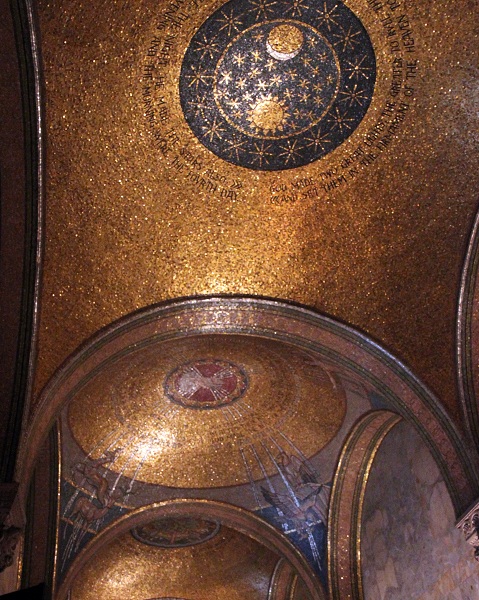Mosaics in narthex of St. Bartholemew’s, New York, by Hildreth Meiere
Museum of Biblical Art
1865 Broadway
(at 61st Street)
New York, NY 10023
Finally, New York gets a chance to see the first exhibit on the work of an artist whose vast output is ubiquitous in and around this city – yet who has somehow until now not been seen fit for serious study. We have previously covered the Catholic artist Hildreth Meiere, her artistic achievement and the revival of interest in her work. Hers is an oeuvre that tens of thousands see but ignore daily. The concise exhibit at the Museum of Biblical Art offers an introduction to her work. That is difficult indeed in the case of an artist who concentrated on large scale public commissions – mosaics, murals, metalwork, windows – for churches and office buildings. What we see is a selection of sketches and models- including full scale mosaics – and then photographs of the finished works. Quite a few of these are in the city or its surroundings so the visitor can immediately follow up with field work of his own. St. Bart’s, Temple Emmanuel, Fordham University Chapel, St. Patrick’s Cathedral – Hildreth Meiere seems to have received commissions from everyone in the 1920’s – 1940’s. And those are only the religious commissions – the current exhibit does concentrate on this aspect of her work.
The exhibit does take us into some unfamiliar ground. Like the monumental former Passionist monastery of St. Michael which still towers over Union City (it is now in the hands of Korean Protestants). Meiere did a number of frescoes there and then contributed additional work after a disastrous fire in the 1930’s. These works depart from her usual manner of that period and seem inspired by the visionary style of Tiepolo. Then, there is the case made to house a book of remembrance in St Thomas, Fifth Avenue: the two angels adorning it are painted in the most classic Art Deco style but in almost surreal, glowing color. In addition to this case, a few altars are the only complete originals on display. These do include, however, two portable altar triptychs – part of a whole series painted for the US military chaplaincies during the Second World War. It seems that in those unenlightened pre-conciliar days it was felt that even masses in the field should be surrounded by at least some elements of beauty.
Artists will enjoy the detailed presentation of the various media in which the artist worked. Meiere was of course extremely sensitive to the requirements of the different techniques and materials. Consider, for example, her description of the effect of the changing sunlight during the course of the day on the appearance of a golden apse mosaic as being of the essence of this medium. We find that many of the mosaics pre-1939 and after World War II were in fact made to her requirements by a firm in bad old Germany. (The instructions on a diagram for installing the mosaics in the dome of the St. Louis cathedral are partially in German).
After World War II Hildreth Meiere still received commissions from some very prestigious clients: St. Bart’s again, St. Louis Cathedral, the Washington National Cathedral. It seems to me, though, that the élan of the earlier decades was lacking (although the colors of the St. Louis cathedral mosaics are marvelous!). Perhaps that was because in the post-war stampede to modernism her work had fallen out of the favor of the critics. But all who are interested today in the interaction of religion and art – and how these could be mutually enriching even as late as the 1940’s – should make it a point to visit this exhibit. And then get out and take a good look again at the marvelous but forgotten works in situ all about us!

Related Articles
No user responded in this post